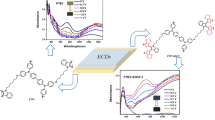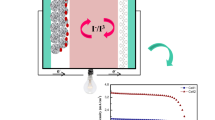Abstract.
We report on the use of electrodeposited poly(3-methylthiophene) (PMeT) in photovoltaic devices. Photocurrent measurements in devices with PMeT as the active conjugated polymer layer were carried out showing that the combination of Ni and tin oxide (TO) as electrode materials presents advantages relative to Al and TO. The choice of these electrode materials permits the carriers with the lowest mobility, the negative charge carriers, to be collected near the exciton generation/dissociation region, i.e. near the transparent TO electrode, avoiding the tendency for space charge accumulation and consequently the reduction of device efficiency.
Similar content being viewed by others
Author information
Authors and Affiliations
Additional information
Electronic Publication
Rights and permissions
About this article
Cite this article
Valaski, R., Silveira, E., Micaroni, L. et al. Photovoltaic devices based on electrodeposited poly(3-methylthiophene) with tin oxide as the transparent electrode. J Solid State Electrochem 5, 261–264 (2001). https://doi.org/10.1007/s100080000147
Received:
Accepted:
Published:
Issue Date:
DOI: https://doi.org/10.1007/s100080000147




